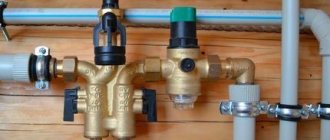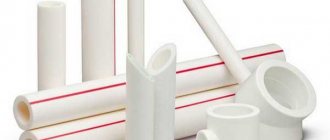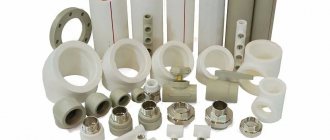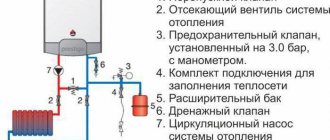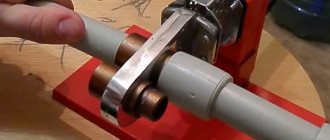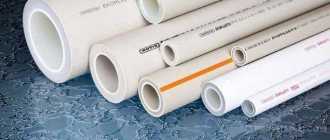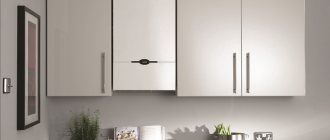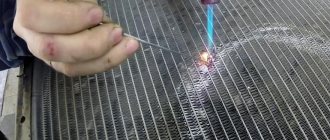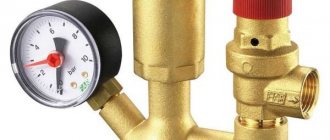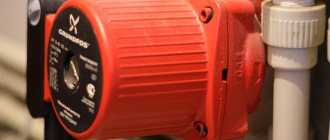Even before designing water heating, a decision must be made on the material for the pipes. Currently, in Russia, preference is given to polymer pipes, less often - metal-plastic, and even less often - stainless steel. Abroad, copper pipes are most often used for heating. They are often used for wiring water systems in private homes. Many years of experience have shown that copper analogues have the best ratio in terms of reliability/practicality.
Advantages
Advantages:
- They can easily withstand heating of several hundred degrees (only at a temperature of 6000 degrees does “annealing” occur, and the pipe begins to lose its strength, acquiring plasticity).
- Capable of withstanding pressure up to 30 atmospheres or more.
- Due to their plasticity, they do not collapse if the water freezes inside.
- Copper has anti-corrosion properties and also does not react to ultraviolet radiation and active chemicals, which increases the service life of the pipe to 50 years or more.
- Do not allow diffusion of air into the coolant through the walls.
- Copper can easily be used at the outlet of a heat generator, because, compared to polymers, it has a low coefficient of thermal expansion (maximum 1.5 mm per linear meter at 900 degrees).
- The internal surface has less roughness compared to steel (but not polymer), which significantly reduces the hydraulic resistance in the system, so less powerful pumps can be used. Due to the absence of roughness, unnecessary deposits do not accumulate inside the pipe.
- Due to the thin walls and fittings, the flow area at the joints remains unchanged, so the hydraulic characteristics of the pipeline do not deteriorate. The entire system is light and compact. Only the outer diameter of the internal section is much larger than that of steel or polymer.
- Copper is safe for humans. It has mild antibacterial properties.
- This is a beautiful material that will not spoil the appearance of the room.
Heating system calculation
Calculating a heating system is a difficult task for a non-specialist. When installing copper in an apartment, there is no choice - you cannot underestimate the internal cross-section of communications, and the internal diameter of the pipes must match that which was in the steel system.
If you are replacing a pre-existing steel system and it worked fine, install pipes with the same internal diameter (in principle, 1-2 mm smaller).
If you are installing a system for the first time, then for a house with an area of up to 100 m², a pipe with an outer diameter of 22 mm for mains and risers and 15-18 mm for connecting radiators is sufficient. For a house with an area of up to 150 m², it is worth using products with a diameter of 28 mm for risers and highways. If the house is more than 150 m² or has three floors, it is better to contact specialists and make a project.
Flaws
Minuses:
- The highest cost among analogues.
- The assembly technique is much more complex than, for example, soldering polypropylene.
- Due to their high thermal conductivity, it is recommended that such pipes be laid in insulating sleeves (foamed), as this will allow heat to be delivered to heating devices with minimal losses.
Assembling a pipeline using fittings
Copper pipes are connected using fittings only in places accessible for inspection.
This rule is due to the fact that the connection is not completely sealed and leaks may form over time. The advantage of a threaded connection is that, if necessary, repairs can be made without additional effort, since the resulting connection is detachable.
Tools and materials
To assemble the pipeline, you will need the following materials and tools:
- copper pipes of suitable diameter;
- connecting crimp or press fittings;
Special devices for pipeline assembly
The types and number of fittings are selected in accordance with the pipeline diagram.
- pipe cutter or hacksaw for metal;
- pipe bender for copper pipes. The device is used to organize a pipeline with fewer connections, which increases the strength of the system;
- file for processing pipes after cutting (before joining). Additionally, you can use fine sandpaper;
- FUM tape for sealing threads. In addition to FUM tape, you can also use linen thread, Tangit Unilok thread or any other sealing material;
- wrench.
Assembly instructions
Assembling a copper pipeline with your own hands using fittings is done in the following way:
- cutting pipes for pipelines. The length of each pipe must fully comply with the diagram drawn up during the development of the system;
- removal of the insulating layer. If pipes with insulation are used for a pipeline system being installed for any purpose, then the insulating layer is removed for a durable connection. To do this, cut the desired area with a knife and clean the pipe;
- The cut edge is processed with a file and sandpaper until a smooth surface is obtained. If burrs, potholes or other irregularities remain at the end of the pipe, the connection will be less tight;
Cleaning the pipe before connecting to the fitting
- if necessary, pipes are bent;
- a union nut and a ferrule are put on the prepared pipe;
Installation of fitting elements for connection
- the pipe is connected to the fitting. Initially, tightening is done by hand and then with a wrench. During the tightening process, the crimp ring completely seals the connection, eliminating the need to use additional sealants. However, when connecting a copper pipe to a pipe or fitting made of a different material, additional sealing with FUM tape is required.
Fixing the fitting
It is important not to overtighten the threads, as soft copper is easily deformed.
Types of Copper Pipe
There is a generally accepted classification, which is based on various criteria for determining the types of pipes.
By wall thickness:
- Thin-walled. The thickness of their walls is approximately from 0.15 to 0.17 mm, so they are practically not used for heating.
- Thick-walled. The thickness in this case ranges from 0.7 mm to 1 cm. For heating, products with a wall thickness of 1-2 mm are most often taken, since with increasing thickness the pressure that the pipe can withstand increases.
According to the condition of the material:
- Unfired (hard). As a rule, it is stamped in sections up to 6 m long. It has high strength, but a low elongation to break coefficient (only 15%).
- Annealed (soft). Appears in connection with the “tempering” of workpieces at a temperature of 600-700 degrees. The loss of strength is directly related to elongation at break. With a loss of strength by 30%, elongation rates will increase to 60%.
Prices for annealed copper pipes
annealed copper pipes
According to the composition of the material:
- pure copper;
- alloys containing zinc or tin.
By manufacturing method:
- drawn (cold-deformed);
- pressed.
By the presence of a seam:
- seamless (no seams);
- from a welded billet.
Products also differ in the presence/absence of protection. There are models without insulation, as well as in a hard plastic casing (polyethylene, PVC), which protects communications from mechanical damage. Products are also produced in a shell made of foamed polyethylene, which prevents uncontrolled heat loss.
Diameter
Previously, it was indicated in inches, but in the latest version of GOST 617 of 2006, the dimensions are given in millimeters. The new document specifies more than 70 standard sizes for outer diameters from 3 to 350 mm only for cold-deformed copper pipes. However, foreign and some Russian manufacturers still mark their products in inches.
To characterize a pipe, the nominal, external, or internal diameter can be indicated. In practice, when selecting connecting elements, they use the concept of conditional passage, meaning the size of the internal clearance. Domestic manufacturers indicate it in millimeters, while foreign manufacturers indicate it in inches.
The throughput of pipelines is calculated based on the internal diameter, and classification is made based on the external size. The nominal diameter is a value approximately equal to the nominal diameter, but with an indication of the exact value.
When converting units of measurement, it should be taken into account that the internal cross-section of an inch pipe (1″) is 33.5 mm, although in the metric system this value is 25.4 mm. The discrepancy is due to the fact that in the document it is indicated by the nominal diameter, and the outer size of imported products is in inches. Therefore, a 1″ pipe inside can be from 25.5 to 27.1 mm. To convert the cross-sectional value from one system to another, use the table:
| Inches | External diameter, mm | Conditional bore, mm |
| 1/4 | 13,5 | 8 |
| 3/8 | 17 | 10 |
| 1/2 | 21,3 | 15 |
| 3/4 | 26,8 | 20 |
| 1 | 33,5 | 25 |
| 1 1/4 | 42,3 | 32 |
| 1 1/2 | 48 | 40 |
| 2 | 60 | 50 |
| 2 1/2 | 75 | 70 |
| 3 | 85,5 | 80 |
| 3 1/2 | 101,3 | 90 |
| 4 | 114 | 100 |
| 5 | 140 | 125 |
When converting inches to millimeters and vice versa, an error is obtained that should be taken into account when choosing pipes of the required diameter. The result is rounded up. Frequently encountered data is shown in the table:
| Inches | Millimeters |
| 1/2 | 20 |
| 1 | 25 |
| 1 1/4 | 32 |
| 1 1/2 | 40 |
| 2 | 50 |
| 2 1/2 | 65 |
| 3 | 89 |
| 4 | 100 |
Russian marking of copper pipes
Manufacturing method: drawn - D.
Section shape: round - KR.
State:
- soft - M;
- semi-solid - P;
- hard - T.
Dimensions: outer diameter and wall thickness.
Length: multiple of measured length - CD.
Delivery form:
- segments;
- bays;
- in free-winding coils - BT;
- in coils of layer-by-layer ordered winding - BU;
- in coils of flat spiral winding - BS.
Example of marking: pipe DKRM (drawn round soft) 8.0x1 (size) 5000 (length) coils BU (layer-by-layer ordered winding) M1 r GOST R 52318-2005.
Production
Seamless copper products are used for the construction of water supply and heating pipelines. They are manufactured using three technologies:
- cold rolling - deformation of the metal workpiece occurs when passing between rotating rolls. A through hole is created by stitching. The sleeve is then calibrated to the required dimensions;
- cold drawing - is based on pulling the workpiece through a drawing tool (drawing die) with a special channel tapering in length. During the drawing process, the metal is compressed to the required geometric parameters and stretched in length;
- hot pressing - producing a pipe by extrusion (extrusion) through the outlet hole of the matrix.
In industrial production, one of these technologies or a combination of them can be used. The composition of the equipment and technological operations may have some differences, but the basic manufacturing process always consists of the following steps:
- preparation of the workpiece;
- cold rolling or drawing, or hot pressing;
- heat treatment;
- lubrication of pipes and tools;
- processing of finished and intermediate products;
- cutting into dimensional pieces or winding into coils;
- quality control of finished products.
Criterias of choice
Copper models, due to their high cost, must be carefully selected.
In order not to make a mistake, you need to get acquainted with the main selection criteria:
- Compliance with terms of use. The main advantage of the products is their versatility. Suitable for both plumbing and heating systems, because they are immune to constant temperature changes and high pressure. They can withstand loads up to 40 atmospheres and temperatures up to 500 degrees Celsius. They are resistant to ultraviolet radiation and have a low expansion coefficient (7 times less than polymer ones). Also, thanks to the active bactericidal properties of copper, it is absolutely safe for humans. But it is worth paying attention to the fact that copper reacts poorly to chlorine, so interaction with it will quickly render the pipes unusable.
- Cost of material and installation. The cost of copper is several times higher than its analogues (about 4 times higher than the price of plastic). But if we take into account all the work associated with the installation and additional elements, then the final cost of the work is no higher than that of metal-plastic. A press fitting for plastic is much more expensive than a solder fitting for copper. Consequently, the final installation cost directly depends on the footage and the number of fasteners.
- Life time. The trouble-free service life of a copper pipeline is 50 years or more, which is a very good indicator.
- Ease of installation. Pipeline installation takes place in several stages: preparation of the material, its processing and installation. The process itself takes a long time, because it is necessary to cut the pipes, bend them using a pipe bender, and also carry out complete installation of all elements. In the end, everything must be connected using fittings (soldering and crimping).
You should not combine copper with galvanized steel, because due to electrolytic processes the copper will simply be destroyed.
Specifications
Copper is a soft and ductile metal. The density of copper is 8.92 g/cm³, which is higher than that of steel (7.85 g/cm³). Despite its great ductility, copper nevertheless has great strength. Copper works well at high and low temperatures (from -100° to +200°) and does not become brittle or soften. Copper has high thermal and electrical conductivity.
Copper is not subject to corrosion (more precisely, it is passivated by a thin oxide film), but does not tolerate aggressive acidic and alkaline environments.
Small-diameter copper tubes have strength similar to that of steel products; as the diameter of the tubes increases, the strength decreases. The plasticity of the metal makes it possible to produce products with thin and very thin walls. It is possible to produce very thin flexible tubes with thin walls - with a diameter of 3 mm, which makes copper products indispensable in the manufacture of some instruments, refrigeration and climate control equipment, chemical equipment, and vehicles.
Chemical inertness makes copper products very durable - the service life of utility networks made of copper reaches 100 years (perhaps even more).
Pipe joining methods
According to docking technology, they are considered universal. Any of several connection methods will do, which is a definite plus.
Depending on your goals, you can choose:
- welding;
- mechanical assembly (pressing, compression connection, clamping with self-locking fittings);
- soldering (hard or soft solder).
For welding, a diameter of 100 mm with a wall thickness of more than 1.5 mm is suitable. Mechanical assembly is only suitable for open areas. If the site is hidden in monoliths or in building structures, then such fittings will be expensive. Domestic heating systems typically use soft soldering. It requires special capillary fittings to operate.
Connection technique
When connecting copper pipes with your own hands, follow the following algorithm:
- cut the workpieces to the required size;
- the edges are cleaned for a quality connection;
- the holes are widened, but if copper pipes will be used in heating systems when the energy carrier is heated above 110°C, fittings are installed;
- parts of the parts are inserted into each other, while maintaining a gap;
- the seam is heated with a gas burner;
- fill the seam with liquid solder, preventing the formation of voids and lumps of solder;
- The connected parts are left for some time to completely cool the welding site; it is forbidden to move sections of copper pipes.
If all points of the copper pipe welding algorithm are followed, a reliable connection is achieved.
Flux for welding copper pipes
Do-it-yourself copper pipe soldering technology
Before you start soldering, you need to briefly familiarize yourself with the theory so that the process is easier and clearer. In everyday life, when installing plumbing and heating systems in apartments, soft soldering is used, in which the contact points are heated to 250-300 degrees, which allows the soft solder (tin) to melt. But, despite the apparent ease, such a temperature is dangerous for copper, so everything must be done very carefully and correctly.
Preparation for capillary soldering:
- Cut the pipe to the required size.
- We chamfer the end of the workpiece (this manipulation will reduce the hydraulic resistance at the joint).
- We clean the outer surface of the pipe and the inner surface of the fitting with an abrasive sponge. This will get rid of the oxide film.
- We distribute flux paste over the entire contact area, which will provide soft solder. To make the solder hard, you do not need to use paste.
- With a slight twist, we put the fitting on the pipe until it stops.
- Remove the flux paste from the work surface with a rag.
You can start soldering.
Low temperature soldering of copper pipe:
- We heat the joint until the flux paste begins to melt. To do this, move the burner nozzle smoothly and evenly around the neck.
- After the flux has heated up, apply solder to the entire surface of the connecting seam. We do not touch the solder wire with the burner fire, since the tin needs to melt not from direct contact with the fire, but from the high temperature of the copper product.
- The melting and soldering process is complete. We are waiting for the product to cool completely. The cooling process cannot be accelerated - everything must cool naturally without improvised means.
- At the end of the work, we remove all the flux paste from the part, because it destroys the protective layer of copper products.
Reviews and operating experience
Some people consider copper pipes an excellent solution, while others do not accept them. But, in fact, this is typical for any technology and material. The only thing that people pay attention to and what is worth listening to is the fact that in an acidic environment, copper begins to deteriorate. Therefore, fill the system with either coolant with a neutral PH or slightly alkaline. It is also not recommended to use steel, aluminum or cast iron radiators. It is imperative to protect the system from stray currents (grounding and dielectric gaskets are required), otherwise chemical or electrochemical destruction begins. But in central heating systems you will not completely get rid of destruction: the coolant in them is saturated with iron, and if solid particles can be retained by a filter, then there is no escape from those dissolved in it.
Another piece of advice from an experienced installer: copper is very sensitive to contact with concrete (it oxidizes). The rate of destruction depends on the composition of the wall, but in any case it is better to lay the pipe in a PVC sheath or any insulator with similar characteristics.
Copper pipes react actively with concrete, so it is better to lay them in a protective shell
Another tip from the master, but this already concerns soldering: it is important not to overdo it. Firstly, from an overabundance of diligence, you can weld the entire lumen (if a pipe of small diameter is especially important), secondly, when the soft solder overheats, the paste is overheated, which is why it cokes, which leads to the formation of fistulas, and thirdly , do not overdo it with the amount of solder. If you have no experience, practice welding on small pieces of pipe: you can check both the clearance and tightness of the connection. And after gaining at least some experience, you can begin welding the system.
How to paint copper pipes
After installation work, the pipeline can be painted to protect it from corrosion and give it an aesthetic appearance. Let's consider which paint is suitable to achieve the above goals.
The following paints would be a good choice:
- polyurethane;
- alkyd;
- PF-115, 156, 167, 187, 223, 519;
- GF-0119.
Prices for PF-115
PF-115
Varnishes that work well include:
- a mixture of ethylene coating with aluminum powder (ratio 9:1);
- VL-51.
It is contraindicated to use oil paints, because they darken when exposed to high temperatures!
Before painting, the surface should be cleaned and coated with lead lead primer No. 81. When painting, you should take into account that the paint is not absorbed into copper, and, therefore, it is necessary to carefully shade the applied composition. It is best to spray paint with a spray can, because with its help you can get a high-quality surface.
Installation
During the preparatory work, pieces of pipe of the required length are cut. It is better to use a special hacksaw or pipe cutter in the process. After cutting, the inner and outer sides of the resulting pipe must be cleaned of chips and burrs. Use a scraper or file. Next, level the place where the pipe was cut.
Application of pipe bender
If it is necessary to make complex sections with turns, then use a special tool - a pipe bender. It will prevent the formation of flattening and creases. It pays to bend the pipe well. Poor workmanship can lead to corrosive damage over time as the flow pattern of the water supply changes.
Cost of copper pipes
Copper pipes for heating and water supply can be bought in Moscow at a good price. The cost depends directly on the size and diameter. This table shows manufacturers of copper pipes for heating, prices per meter and kilogram. Read how to calculate Gcal for heating by area on our website.
Areas of application
Copper pipes are used very widely:
- In heating systems. Strength, non-corrosion, durability, high thermal conductivity make copper products very attractive for laying heating systems. The widespread use of copper pipes for heating is hindered only by their price.
- In water supply systems. The idea of laying an almost eternal water supply system is always tempting.
- In gas pipelines of small diameters - usually this is gas distribution in a house or apartment. Copper and its alloys are the material of first choice in the production of gas equipment and the laying of low and medium pressure gas pipelines.
- In hydraulic control systems in the energy sector.
- In vehicles and some equipment, copper fuel pipelines and brake system pipelines are used.
- In heat exchangers in all kinds of refrigeration and air conditioning equipment - not a single refrigerator or air conditioning system is possible without the use of copper pipe with its high thermal conductivity; in solar panels.
- In mechanical engineering, aircraft manufacturing, in industry in all kinds of hydraulic systems.
- In measuring technology.
- In some types of industrial equipment and devices, household appliances.
- In heat exchangers and heat sinks, heat pipes. For example, every PC has a computer cooler - a device for cooling the processor of a personal computer.
- Particularly worth highlighting are gas heating boilers and water heaters that are so close to private homeowners - in them, heat transfer occurs through a copper heat exchanger.
Advice from experienced installers
A lot of useful information about the installation of freon pipes can be obtained from experienced installers of air conditioning systems
It is especially important to convey this information to designers, since one of the problems of the design industry is its isolation from installation. As a result, projects include solutions that are difficult to implement in practice.
As they say, paper will endure anything. Easy to draw, difficult to execute.
By the way, this is why all advanced training courses at the APIK Training and Consulting Center are conducted by teachers with experience in the field of construction and installation work. Even for management and design specialties, teachers from the field of implementation are invited to provide students with a comprehensive perception of the industry.
So, one of the basic rules is to ensure at the design level a height for laying freon routes that is convenient for installation. It is recommended to keep the distance to the ceiling and to the false ceiling at least 200 mm. When hanging pipes on studs, the most comfortable lengths of the latter are from 200 to 600 mm. Shorter length pins are difficult to work with. Longer studs are also inconvenient to install and may wobble.
When installing pipelines in a tray, do not hang the tray closer to the ceiling than 200 mm. Moreover, it is recommended to leave about 400 mm from the tray to the ceiling for comfortable soldering of pipes.
It is most convenient to lay external routes in trays. If the slope allows, then in trays with a lid. If not, the pipes are protected in a different way.
A recurring problem for many objects is the lack of markings. One of the most common comments when working in the field of architectural or technical supervision is to mark the cables and pipelines of the air conditioning system. For ease of operation and subsequent maintenance of the system, it is recommended to mark cables and pipes every 5 meters in length, as well as before and after building structures. The marking should use the system number and pipeline type.
When installing different pipelines above each other on the same plane (wall), it is necessary to install lower the one that is most likely to form condensate during operation. In the case of parallel laying of two gas lines of different systems above each other, the one in which the heavier gas flows should be installed below.
